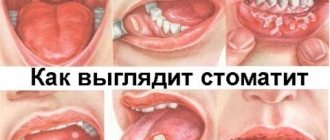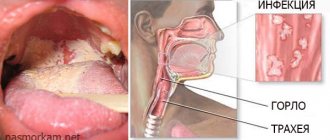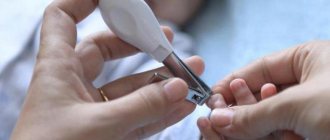Lumps in the mouth: white, yellow, gray - what is it?
These white plugs on the tonsils are tonsilloliths (tonsil stones), also called caseous or purulent plugs. In color they are often white, yellowish, green or grayish. In the “depths” of the tonsils there may be small plugs or plugs weighing up to 40 grams, which must be removed! They can be soft and quite hard, which is explained by the presence of calcium salts in them.
These formations consist of exfoliated cells of the oral cavity and tonsils, food debris and many bacteria.
Most often, staphylococcus or streptococcus are present. But there may also be chlamydia, Candida fungi, and viruses. The presence of these microorganisms leads to inflammation of the tonsils and general intoxication of the body.
When there are white lumps in the lacunae, there is a feeling of soreness in the throat, as if something foreign and interfering has appeared on the walls of the larynx. Corks are very smelly and can cause bad breath. Or there may be no signs of their presence at all. Only when coughing or sneezing do they fly out of their homes.
Congestion in the tonsils also occurs in healthy people who once had a sore throat. If their presence does not cause unpleasant or painful symptoms, then treatment is not required. The tonsils are capable of self-cleaning; gradually these plugs come out on their own.
Reasons ↑
A suppuration in the throat can occur when bacteria enters there immediately before the disease.
Microbes enter through the air through close contact with an infected person through inhalation. In a dormitory, office, school, kindergarten, or home there are all conditions for the transmission of infection due to close contact between people.
Also, microbes can live indefinitely in the body and become activated due to reduced immunity. A decrease in protection occurs due to hypothermia, drafts, allergic diseases, the ingress of harmful substances along with the inhaled air, overwork, and stress.
The appearance of pus also occurs during inflammatory processes in the nose. The natural outlets from the sinuses are located in such a way that the pus flows into the throat on its own or the sick person “sucks” it and coughs it up.
Diseases in which this disease can be detected are divided into:
- purulent inflammation of the paranasal sinuses or sinusitis: sinusitis (maxillary sinusitis);
- sinusitis of other sinuses (frontal, main, ethmoidal labyrinth);
- purulent pharyngitis;
Inflammation can progress to a purulent stage with severe injuries to the bones of the facial skeleton or prolonged residence of foreign bodies in the nose and paranasal sinuses. Buttons, seeds, and pebbles are inhaled by children due to pranks and the habit of putting objects up their noses.
Causes of lumps on the tonsils
The exact reasons for the formation of these lumps in the tonsils are unknown, as is why some people suffering from chronic tonsillitis develop them and others do not. Read about the reasons for the formation of holes in the tonsils here.
Men are twice as likely to develop white lumps in their tonsils than women.
It is a mistake to think that these are food remains that have clogged into enlarged gaps and rotted there. This is not entirely true. Official medicine claims that these are characteristic manifestations of chronic tonsillitis.
The disease occurs against the background of frequent colds, weakened immunity, fatigue, drinking cold drinks or chilled food. The tonsils and mucous membrane of the pharynx become inflamed, the structure of the tonsils changes, and the lacunae deepen. Bacterial flora lingers in these depressions and pathogenic microorganisms multiply. They accumulate and form lumps ranging in size from tiny grains to a couple of centimeters.
This article will help you understand what are the symptoms and treatment of inflammation of the tonsils and how you can reduce inflammation.
But what purulent plugs in the tonsils look like and what treatment is needed is described in detail in this article.
This article will help you understand how ulcers on the tonsils are treated without fever: https://prolor.ru/g/lechenie/gnojniki-na-mindalinax-bez-temperatury.html
Read about the treatment of enlarged tonsils in children here.
Causes of ulcers
If skin care is really chosen correctly, but ulcers still form, what could this be due to? Doctors name several different reasons:
- increased sweating (result – rash on the back, shoulders, chest);
- hyperkeratosis (may be hereditary), when the upper layers of the epidermis quickly become coarser and the pores expand;
- long-term use of antibiotics, hormonal drugs;
- hormonal changes in the body in women (before menstruation, during menopause);
- prolonged depression and stress (affect hormone production);
- noticeable lack of vitamins (especially group B);
- poor nutrition and chronic lack of sleep.
In women who regularly use cosmetics, the appearance of ulcers is associated with:
- comedogenic properties of creams;
- poor quality skin cleansing in the evenings (when makeup is not completely removed);
- samples of “not my own” products (a friend let me use her foundation or powder with puff, etc.).
Also, the appearance of pus and the formation of large pimples are associated with independent attempts to remove small rashes. Have you seen a small pimple and couldn't resist touching it?
Then don’t be surprised that after a few days, swelling and redness will appear in the same place, and then an abscess will come out.
Treatment
To get rid of these lumps, you need to treat chronic tonsillitis and prevent its aggravation. Chronic tonsillitis is dangerous because it causes complications in the heart, joints, and kidneys. The disease can also develop into a decompensated stage, when the tonsils themselves are no longer a barrier to bacteria, but a source of infection. Then they urgently need to be removed.
The doctor decides how to treat the throat and remove white lumps. You will definitely have to undergo a clinical minimum of tests: a general blood test, a general urinalysis, an ECG, an immunogram, and collection of swabs from the throat for sensitivity to microorganisms. Depending on the results of the analysis, the doctor will prescribe antibiotics or bacteriophages and prescribe a course of treatment.
As a rule, the approach is comprehensive and consists of the following tasks:
- Cleansing the tonsils by washing out or suctioning out lumps and mucus that have formed.
- Reducing swelling of the tonsils.
- Preventing possible allergic reactions.
- Restoring the normal functioning of the tonsils and their participation in the formation of immunity.
- Increasing the body's immunity in order to avoid recurring inflammation.
Treatment and prevention of oral diseases
As already mentioned, the reasons for the appearance of white ulcers in the oral cavity can be bacteria and viruses when the immune system is weakened and as a result of acute vitamin deficiency.
Thus, having identified the cause of the disease, a course of appropriate treatment is prescribed.
Thus, when ulcers form in the mouth as a result of decreased immunity and vitamin imbalance, treatment is aimed at increasing the body’s protective functions and saturating it with essential vitamins. Local treatment of the oral cavity consists of rinsing with antiseptic and anti-inflammatory drugs. Such rinses should be done after every meal.
We suggest that you familiarize yourself with Irrigation of the throat with chlorhexidine - ORZ specialist
More details about the procedures
Rinsing tonsils if there are green or white plugs that can smell very bad
Pathogenic microbes and dead leukocytes, accumulating inside the tonsils, cannot leave them themselves, because there are many voids and winding channels there. They can only be washed. The procedure is performed in a clinic or hospital by an otolaryngologist.
It is impossible to properly wash corks at home. In addition, there is a danger of “driving” the infection even deeper, injuring the tonsils or palate.
Today, doctors use two methods of washing lacunae - with a syringe or the Tonsilor device.
Flushing with a syringe
The method is the most common and often used in district clinics.
A brass rod is attached to the syringe, the tip of which is replaceable.
The patient's larynx is treated with lidocaine so that it becomes less sensitive and the unpleasant sensations are less intense. A syringe with a special tip (cannula) is used to irrigate the lacunae with a special solution, and under the pressure of the liquid, purulent plugs, white lumps, microbes and their waste products are washed out. The medicinal solution helps stop inflammatory processes.
The procedure is a little unpleasant, generally painless, lasts about 10 minutes. It is considered traumatic, because the cannula can injure the mucous membrane (this happens if the patient cannot stand it and jerks or the doctor does not have enough experience). It may also seem difficult to those who have a strong gag reflex.
One time is not enough to wash the tortuous and curved “passages”; you need to complete a course of 7-10 sessions. By the way, the gag reflex noticeably weakens after two or three procedures.
Hardware method when processing plugs come out/fly out
A vacuum device "Tonsilor" is used. With its help, the contents of the lacunae are sucked out. Full course – 5 procedures. When treating tonsils with Tonsilor, ultrasound is used. This helps to effectively relieve inflammation and relieve pain in the palate.
Tonsils are not washed in case of acute respiratory viral infections with fever, cancer, or tuberculosis.
After washing the tonsils, it is possible to achieve stable remission; it can last from six months to a couple of years. If at this time you start strengthening your immune system, then you can forget about chronic tonsillitis forever.
The hardware method also has a number of contraindications, for example, it is not suitable for pregnant women.
Very rarely, washing does not lead to remission. This happens when the tonsils are located deep between the palatine arches. Then you need to use other treatment methods.
Physiotherapy if there is an unpleasant or bad odor
Washing gives good results in combination with physiotherapy. The main task of physical procedures is to resume the normal functioning of the tonsils, restore their blood supply and the nearby lymph nodes. Also, physical methods are good for relieving swelling of the palatine arches.
A course of physiotherapy is recommended lasting 10-12 procedures.
The most popular methods:
- Ultrasound . It effectively removes inflammation of the tonsils, but, unfortunately, it is painful for the patient and is not always suitable (it has a number of contraindications).
- UHF warming up . Effectively relieves swelling in the area around the tonsils and lymph nodes.
- UV irradiation. Ultraviolet light gets rid of infection that causes inflammation.
- Laser therapy or tonsillectomy. The tonsils are irradiated with a laser. The method has no contraindications. As a result of laser exposure, swelling is removed. The inflammation goes away.
There are other physiotherapeutic methods (inhalations, magnetic therapy, electrophoresis, etc.). They can only be prescribed by a doctor; you can get them at the district clinic as a day hospital.
Immunostimulating therapy
It consists of taking synthetic immunomodulators (Likopid, Imunofan) or herbal preparations (for example, echinacea or ginseng tinctures, rosehip decoction, Tonsilgon drops or dragees. Instructions for using Tonsilgon dragees can be found at the link.
Sinusitis and sinusitis
Sinusitis and sinusitis begin with a cold or viral infection. After a few days, the patient notices the appearance of thick yellow-green nasal discharge, feels headache, discomfort, and distension in the sinuses.
Tonsillitis. A chronic, recurrent process depletes the body's strength and causes discomfort when eating and drinking. Those who are susceptible to this disease may notice white spots on the loose surface of the almonds. These are purulent plugs that have a very unpleasant, purulent odor.
What can you do at home?
Tonsil rinsing at home is difficult to do. Leave this procedure to your doctor. At home, rinsing will be more effective. The causes of white plaque on the tonsils without fever can be found at the provided link.
You should gargle efficiently, thoroughly, with your head thrown back well and holding it in this position for 30 seconds. If the tonsils are inflamed, rinse 4-6 times a day, or even more often. If the palate is not inflamed, and white lumps fly out when coughing, you should gargle at least twice a day - morning and evening.
A solution for rinsing can be purchased at a pharmacy (Chlorphilipt, Chlorhexidine, Furacilin, Miramistin. We recommend reading about the use of Miramistin for a runny nose. You can rinse with a decoction of chamomile, oak, sage, calendula, sea salt solution. Water with propolis tincture, drops of tea tree oil - This is not the entire list of those solutions that will effectively clear the throat and relieve inflammation.
We recommend that you read about the reasons why a cyst forms on the tonsils in this material.
Gargling
Gargling is also an equally effective procedure, the purpose of which is to remove white lumps. Thanks to it, pathogenic microorganisms are destroyed and the pharynx is disinfected. You need to gargle 3 times a day until completely cleansed.
The following solutions are used for the procedure:
- Hydrogen peroxide;
- a weak solution of manganese or iodine;
- alcohol tinctures of eucalyptus, calendula;
- solutions of Streptocide, Furacilin - you need to dissolve one tablet of the drug in a glass of water;
- baking soda or salt solution;
- decoctions of sage, chamomile.
However, carrying out such a seemingly simple procedure requires special attention, since it is very important to adhere to the recommended proportions. After removal of purulent plugs from the tonsils, it is forbidden to consume food and drinks.
However, rinsing the pharynx is a rather complicated procedure, so it is carried out in an ENT office, where a specialist acts on the tonsils with a water jet containing a solution of Furacilin or iodine, washing out the remaining pus from there, as a result of which white pebbles fly out of the oral cavity.
The same procedure can be carried out using a bulb or syringe. To prevent water from entering the respiratory tract, the patient's head should be tilted forward or down.
Prohibited “tricks” on how to remove smelly pus plugs from your throat
It is forbidden to squeeze out purulent plugs with your fingers, or pick out white lumps with matches, cotton swabs, or toothpicks! In fact, only formations located close to the “exit” can be removed in this way.
You won’t be able to reach those that lie deep; you can drive them even deeper and you will probably injure the mucous membrane!
After such interventions, pain and inflammation of the mucous membrane are ensured. And complications may occur, including blood poisoning.
What complications can there be?
If a purulent wound is not treated, the inflammatory process will spread deeper and deeper, affecting healthy tissues and disrupting the functions of adjacent organs. All purulent foci are healed by secondary intention, which means that the formation of a scar and cosmetic defect is guaranteed in most cases.
Long-term complications include:
- lymphadenitis;
- thrombophlebitis;
- purulent abscess;
- phlegmon;
- meningitis;
The severity of complications depends on the location of the purulent focus. The most dangerous are lesions of the neck, when it can spread deep into the fascia, and from there go into the bloodstream, rushing straight to the brain.
Video
This video will tell you about the reasons for the appearance of white lumps in the throat.
White, yellow, gray lumps from the throat with an unpleasant odor (they may smell bad or be stinky) are characteristic signs of chronic tonsillitis or evidence of a previous throat disease. Whether to fight them or not depends on how much they interfere with you. Sometimes they can appear in healthy people, and this is only a sign of self-cleaning of the tonsils. You can remove them by thoroughly rinsing your throat and clearing your throat. When there are obvious signs of inflammation of the tonsils, pain in the throat, you should immediately consult a doctor and strictly follow his instructions. Maybe
Is it possible to remove white lumps from the throat on your own?
It is strictly forbidden to squeeze, pick out or perform other manipulations to remove plugs . Even if you manage to remove the top layer of caseous masses, you cannot remove the deep-lying white lumps yourself at home. During such special procedures, you can easily damage the mucous membrane, cause an infection and only aggravate an already significant problem.
Don’t put all the available remedies in your mouth, such grief-treatment will not bring the slightest relief!
Sinusitis
An unpleasant odor, which the patient himself feels, is a sign of sinusitis - inflammation of the paranasal sinuses (maxillary, frontal). In this case, additional symptoms arise that indicate the localization of the pathological process:
- Nasal congestion.
- Mucopurulent discharge.
- Pain in the zygomatic or frontal area.
With acute sinusitis, the temperature rises and the general condition is disturbed. Adults and children suffer from headaches. Upon examination, you can notice that a strip of exudate flows down the back wall of the pharynx. Because of this, coughing often occurs at night.
We suggest you familiarize yourself with Feeling of dryness on the tongue
Aphthous stomatitis
This type of disease is characterized by inflammatory processes, the course of which occurs in a chronic form. With this disease, small abscesses appear in a person’s mouth, bringing him painful sensations of an acute nature. When aphtha appears in a place where the force of friction constantly prevails, then after treatment the patient may be left with scars.
Most often, pustules in the mouth in such cases are formed as a result of various inflammatory processes that affect the patient’s intestines. Also, sores in the oral cavity can be evidence of a person having psychological problems such as depression, emotional stress and others. Also, white sores in the mouth with aphthous stomatitis appear as a result of female problems with menstruation.
Ulcers in the oral cavity can heal quite quickly, in a maximum of six days, but there are cases when ulcers do not heal for a long time, up to one month.











